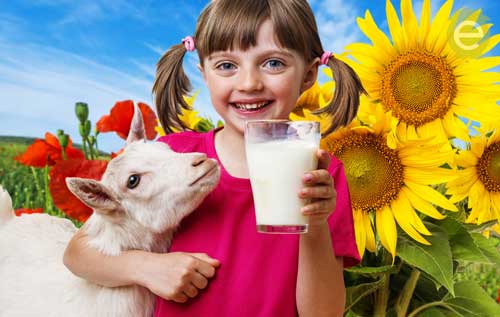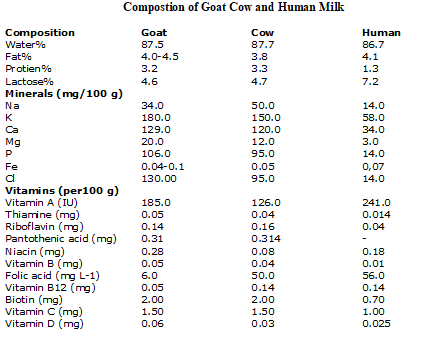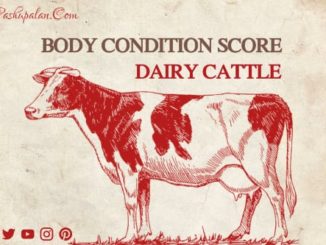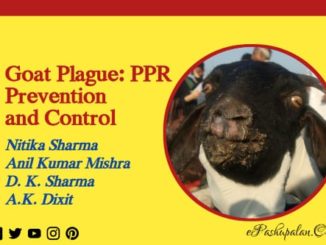The goat was the earliest ruminant to be domesticated in the mountains of Iran. Goat is generally known as ‘poor man’s cow’ because they act as insurance against disaster due to their short generation interval, high rate of prolificacy and ease in management and marketing over large ruminants. They can greatly contribute to the agrarian economy, especially in low fertility areas where crop and dairy farming are not economical, like state of Uttarakhand. The Gaddi goat, which greatly resembles the ancestral wild goat, was used as a beast of burden in the mountains and is popular in high altitudes of the state. The productivity of Uttarakhand goat is low, yet considering the nutritional and physical environmental conditions under which they are reared, it cannot be considered inefficient. The low productivity can be improved by organized efforts for genetic improvement. There should be upgrading of herd by selection of breeding bucks and inter-mating should be avoided.
Goats produce approximately 2% of the world’s total annual milk supply. It is estimated that 60% of the world’s goat population is located in Asia. It suggests that their contribution to nutritional and economic well being is tremendous in Mediterranean and tropical countries. India is reported to have 135 million goats (19th livestock census) and Uttarakhand ranks 5th state in the country. Indian goat milk production represents 26.5 % (4, 114, 290 tonnes) of the world share followed by 18% by Mediterranean countries (FAO, 2011).

GOAT MILK: NUTRITIONAL BENEFITS
Goat milk is categorized as a functional and therapeutic food in the recent researches. A functional food acts on human body beyond basic nutrition. It has additional function of health promotion or disease prevention by its natural or additional ingredients. The unique and beneficial characteristics of goat milk that are superior to bovine milk include: better digestibility; greater buffering capacity; fat globules that are smaller in diameter and better distributed in the milk emulsion; higher content of short-chain fatty acids in the milk fat; higher content of zinc, iron and magnesium; stronger lacto peroxidase (antimicrobial) system as well as better immunological and antibacterial characteristics. As compared to cow milk, goat milk composition is much similar to human milk.

The exact composition of goat milk varies according to factors such as breed, individual animal, diet and feeding, environmental and regional or local conditions, lactation period and health status.
The short chain fatty acids, medium chain fatty acids (capric, caproic, caprylic) and medium chain triglycerides are useful therapeutically for medical treatment of intestinal resection, malabsorption syndromes, chyluria, hyperlipoproteinaemia, infant malnutrition, premature infant feeding, cystic fibrosis, coronary by-pass, steatorrhoea and gallstones. These fatty acids are utilized for direct energy production and not deposited in adipose tissues or blood vessels thus reducing the risk of cardiovascular disease.
Goat milk has higher levels of essential and free amino acids. It contains high amount of threonine, lysine, isoleucine, cystine, tyrosine and valine and taurine. Taurine is 20-40 times higher in goat milk than cow milk. It is known for its beneficial effect on the health of kidneys and urogenital tract. It also reduces muscle fatigue and improves exercise capacity.
Goat milk has αs1, αs2, β and ĸ casein species like cow milk. But goat milk has higher proportion of β casein and cow milk has higher proportion of αs1 casein. It makes goat milk more similar to human milk which lacks αs1 casein. This composition imparts better digestibility and low allergenicity and softer curd forming properties to goat milk. Moreover, goat whey and casein protein derived peptides are bioactive and have antimicrobial properties.
Carbohydrates other than lactose found in goat milk are oligosaccharides, glycopeptides, glycol–proteins, and nucleotide sugars in small amounts. Goat milk is rich in acidic and neutral oligosaccharides and contains 10 times higher oligosaccharide content than cow milk. Oligosaccharides present in milk are prebiotic and antimicrobial substances.
High amount of minerals present in goat milk aids in improved lactose digestion as they form part of many enzymes involved in lactose hydrolysis. Selenium and glutathione peroxidase content is higher in goat milk which constitutes defense mechanism against oxidative stress, bacterial diseases (typhoid, pneumonia), viral diseases (e.g.dengue) and cancer. The Ca, P and Mg are present in soluble form and are biodigestible. Vitamin A, thiamin, riboflavin and pantothenate are higher in goat milk but it is deficient in folic acid and vitamin B12 .
VALUE ADDITION OF GOAT MILK: TECHNOLOGICAL HURDLES
Goat milk and its components are endorsed as functional foods because they possess physiological functions beyond nutrition. The technological variation in processing of cow and goat milk is due to biochemical variation in their protein and lipid profile.
Goats’ milk has some particular properties that confer technological advantages in comparison to cow’s milk, such as a smaller size of fat globules. Goat milk has 80% fat globules <5µ which provides a smoother texture in derived products. The lower amounts of as1-casein, resulting in softer gel products, a higher water holding capacity and a lower viscosity.
Goat milk lacks agglutinating globulins that facilitates fat globules of cow milk to cluster during curd formation. The unique goaty flavor due to higher proportion of short and medium chain fatty acids, salty taste and difficulty in fat separation are some of the technological hurdles during processing and value addition of goat milk.
GOAT MILK PRODUCTS
The chemical characteristics of goat milk can be modified using supplements/fortificants/bacterial cultures to manufacture a wide variety of products, including fluid beverage products (low fat, fortified, or flavored) pasteurized or ultra heat treated milk, cheese, yogurt, frozen products such as ice cream or frozen yogurt, condensed/dried products like goat milk powder.
Cheese is the predominant product produced from goat milk in European countries. The market in India is growing at the annual rate of 20%. The goat milk cheese is used to prepare continental cuisines by five star hotels. The Central Institute for Research on Goats, Makhdoom has standardized the procedure of heat and acid coagulated paneer. In this process fresh goat milk is heated to 87-88oC and milk is coagulated by adding citric acid granules (0.15%) W/W. There are several initiatives in India where goat milk is mixed with cow or buffalo milk for cheese production. This technique helps in improving sensory and quality attributes of cheese specially mozzarella and cheddar buffalo milk cheese.
Probiotic yogurt is one of the most popular fermented dairy products commercialized as functional food. The texture of the fermented products is strongly dependent on milk supplementation or fortification and less on culture composition. The most important factors in the acid curd structure formation are casein content, pH and calcium content of the milk. A mixed starter comprising Lactobacillus acidophilus, Bifidobacterium lactis and Streptococcus thermophilus has been successfully used for fermentation of goats’ milk , and a high viability of probiotic strains in a fermented goats’ milk stored at 4 oC for 10 days has been reported. Goat milk fortified with whey protein and soy protein using probiotic strains of Streptococcus thermophilus, Lactobacillus bulgaricus and Bifidobacterium bifidum was successfully used to produce yogurt with improved sensory and health attributes.
Goat milk spray dried powder is also an upcoming product which is taking up its toll due to higher shelf life. It is demanded by families of European embassies situated in Delhi and is gradually fetching the attention of urban metro consumers.
In Uttarakhand state initiatives have already started towards development of goat milk products in Haridwar and Dehradun districts. Bakri chaap is one such venture which is adopting a aberrant marketing practice to commercialize its products. They are selling pasteurized bottled goat milk.
GOAT MILK PROSPECTS
Developed countries are the main producers and consumers of cow milk. Much of their research is concentrated on altering milk components by incorporation of probiotics/prebiotics and manipulating the lipid and protein profile of milk. However, in developing countries milk of sheep, goat and camel is also consumed. The Mediterranean and Middle East countries have already started developing and commercializing goat milk products. Goat farming is well established among rural poor however, unorganized. Also, goat milk and milk products are not acceptable in all the strata of Indian society. In India therapeutic use of goat milk is documented in Ayurveda and Bhavprakash. There has been a renewed interest in goat farming in recent decade. It is proven that goat milk has tremendous potential to act as functional food and can create a niche zone in Indian market like in France and USA. The use of goat milk becomes an opportunity to diversify the Indian dairy market. In order to increase consumer acceptability alteration of goat milk for product development is an area of concern to be concentrated by dairy researchers. It will contribute to the health of Indian consumers and will assist the goat rearing marginal farmers on economic front.






3 Trackbacks / Pingbacks